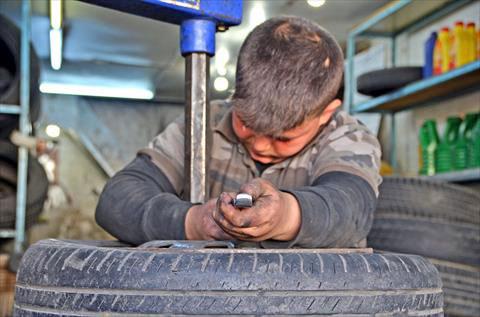You are here
Eliminating child labour requires comprehensive plan
By Mays Ibrahim Mustafa - Jun 16,2023 - Last updated at Jun 16,2023

Today, 160 million children are still engaged in child labour, ccording to a statement issued by the International Labour Organisation on World Day Against Child Labour, observed on June 12 (File photo)
AMMAN — Eliminating child labour requires a comprehensive approach that addresses its root causes by tackling poverty and increasing children’s access to quality education, according to experts.
The Ministry of Labour handled 231 cases of child labour during the first five months of 2023, compared with 149 cases during the same period in 2022, according to the ministry’s spokesperson Mohammed Zyoud.
The Director of the Phenix Centre for Economics and Informatics Studies Ahmad Awad noted that poverty is the “greatest driving force” behind child labour.
Combating child labour is closely linked to expanding access to quality public education for all boy and girls, promoting decent work for adults and mitigating economic household vulnerabilities, he told The Jordan Times.
Economist Husam Ayesh said that the lack of decent employment opportunities for adults and youth, as well as decreases in household income, are linked to increases in child labour rates.
Jordan’s unemployment rate during the first quarter of 2023 stood at 21.9 per cent, according to the Department of Statistics.
Ayesh explained that employers hire children mainly due to their beliefs that they are easier to manage than adults and are less likely to complain about unfair working conditions.
It also enables employers to keep their costs low through paying “extremely low” wages and avoiding legal obligations related to social security and health insurance, he told The Jordan Times.
Child labour jeopardises victims’ prospects for decent work in youth and adulthood, by denying them access to education and limiting their growth opportunities, added Ayesh.
“Since 2000, for nearly two decades, the world had been making steady progress in reducing child labour. But over the past few years, conflicts, crises and the COVID-19 pandemic, have plunged more families into poverty — and forced millions more children into child labour.
“Economic growth has not been sufficient, nor inclusive enough, to relieve the pressure that too many families and communities feel and that makes them resort to child labour. Today, 160 million children are still engaged in child labour. That is almost one in ten children worldwide,” according to a statement issued by the International Labour Organisation on World Day Against Child Labour, observed on June 12.
Zyoud told The Jordan Times that the ministry’s approach to dealing with detected child labour cases relies on cooperating with the Ministry of Education, which deals with school dropout cases, and the Ministry of Social Development, which works on providing assistance for vulnerable households with working children through the National Aid Fund.
He added that the ministry conducts a number of inspection campaigns targeting child labour every year, and 15 per cent of its daily inspection visits are allocated to ensuring employers’ commitment to labour laws related to hiring children under the age of 18.
He also noted that the ministry continuously works on developing its inspection mechanisms to ensure their efficiency and transparency.
This includes training its human resources and building their capacities in addition to equipping inspectors with cameras and tablets linked to a central control room at the ministry to guarantee the integrity of relevant proceedings, he said.
According to Zyoud, people can report child labour cases through childlabor.mol.gov.jo. He added that the ministry’s Himaya (protection) platform, primarily developed for receiving labour-related complaints, also allows employers to object to inspection procedures.
Related Articles
AMMAN — The Ministry of Labour handled 507 cases of child labour in 2023 and 259 warnings have been given to employers violating the law by
AMMAN — As Jordan marks the World Day against Child Labour on Monday, experts across a variety of disciplines are calling for urgent c
AMMAN — On the occasion of the World Anti-Child Labour Day on Wednesday, the Labour Ministry on Tuesday announced that it has dealt with 197
















